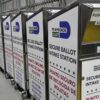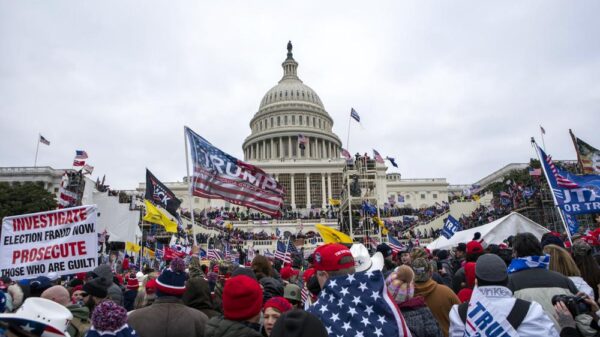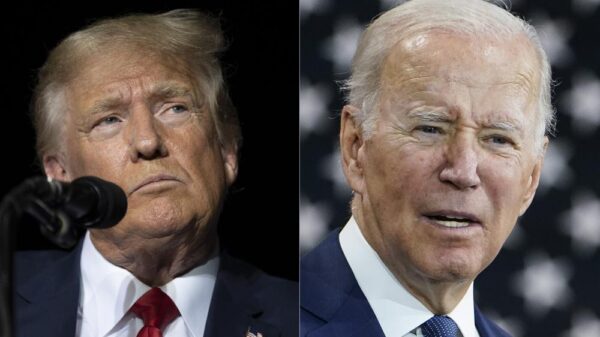In this Nov. 3, 2020, photo, Mikara Stewart, 5, looks around a voting privacy kiosk while her unseen grandmother Doris Thomas, votes in Precinct 36 after standing in line for almost two hours in Jackson, Miss. The 2020 presidential election officially entered the record books Saturday the turnout reached 61.8%, eclipsing the recent mark set by Barack Obama’s first presidential campaign in 2008 and demonstrating the extraordinary engagement of Americans in the referendum on Donald Trump’s presidency. (AP Photo/Rogelio V. Solis)
With votes still being counted, turnout in the 2020 presidential election has hit a 50-year high, exceeding the record set by the 2008 presidential election of Barack Obama — an extraordinary engagement in what amounted to a referendum on President Donald Trump’s leadership.
As of Sunday, the tallied votes accounted for 62% of the eligible voting-age population in the U.S. That’s a 0.4 percentage point increase so far over the rate hit in 2008, when the nation elected its first Black president.
The sheer number of votes also set records, although that’s a less remarkable milestone given the country’s growing population. So far 148 million votes have been tallied, with Democrat Joe Biden winning more than 75 million — the highest number for a presidential candidate in history. Trump received more than 70 million — the highest total for a losing candidate.
The numbers are certain to rise as election officials continue to count more ballots. But election experts and partisans already are debating the forces behind the swell of civic participation. Some pointed to the numbers as evidence of what happens when states expand the time and the ways voters can cast ballots, as many states did this year. Other noted the extraordinary high passions Trump provoked — both for and against.
The result: the highest turnout since 1968, according to data from the Associated Press and the United States Elections Project, which tracks turnout. Experts think the 2020 rate could hit heights not seen since the beginning of the 20th century, before all women were allowed to vote.
“It’s hard to imagine we can get higher than this,” said Michael McDonald, a political scientist at the University of Florida who runs the Elections Project.
An Associated Press analysis shows that some of the biggest turnout increases to date occurred in states that liberalized their mail-voting rules. In two states where it was expanded significantly, Montana and Vermont, turnout rose by more than 10 percentage points and more than 9 percentage points, respectively, over the previous presidential election, enough to put the states into the top 10 increases. Hawaii saw the biggest turnout increase, a more than 14 percentage point jump so far.
Texas, which did not expand mail voting but gave voters extra time to cast early ballots in person, saw a whopping more than 9 percentage point increase in turnout, moving from 50% to 59% of its citizen voting-age population going to the polls.
Many of the states with the biggest turnout increases — including Arizona, Texas and Georgia — were new battlegrounds in the presidential race, places where Democrats sought to mobilize new voters and shift Republican strongholds. Some analysts noted the number proved the efficacy of voter outreach and organization efforts.
“People vote when they’re asked to vote,” said Seth Masket, a political scientist at Denver University.
But the record high participation, to Democrats’ surprise, did not always help them. The party lost House seats and failed to win enough Senate seats outright to take control of the upper chamber — that now rests on runoffs in Georgia. They also failed to turn a single state legislature from Republican control.
Those results undermine the longtime conventional wisdom that Democrats benefit most from high turnout. It’s a theory even Trump espoused this year, when he warned of “levels of voting” so high that “you’d never have a Republican elected in this country again.”
Democrats were excited about massive early voting in places with normally underperforming electorates, like Texas, “Our position in Texas was always that, we’re not a red state, we’re a non-voting state,” said Gilbert Hinojosa, chairman of the Texas Democratic Party, which had hoped to take control of the Texas House of Representatives.
Instead, Texas Democrats didn’t even come close, despite the jump in voting, losing the presidential vote by 5.5 percentage points, failing to gain any congressional seats or make up ground in the state legislature.
The results had some Democrats second-guessing the party’s decision to idle its door-knocking and in-person voter outreach for months, out of concern about spreading the coronavirus.

“Perhaps we were not reaching the people we needed to for persuasion,” Hinojosa said. “I’ve got to believe that’s just much more effective face-to-face.”
It’s still early to know exactly who turned out on Tuesday. But Tom Bonier, a Democratic data analyst, looked at information from three all-mail states — Colorado, Nevada and Oregon — and saw sizable increases in younger and non-white voters, as well as other core Democratic constituencies.
Calculating historical turnout rates is tricky because of changes in the ways voter records were kept when larger shares of the population were not allowed to vote. Predictions of a record high rate are based on records maintained by McDonald, who has calculated the number of eligible voters every election year all the way back to the founding.
The Associated Press determined the current turnout rate by comparing the number of tallied votes to the Elections Project’s estimated number of current potential voters in the U.S.
Turnout was higher before 1920, when some women won the right to vote, because the pool of people who could cast a ballot was smaller. That’s why McDonald and others think the 2020 election may surpass the 1908 high-water mark of 65.7%.
The highest turnout in the post-World War II era was in 1960, when 63.8% of eligible voters cast ballots, according to McDonald’s records.
The 2020 turnout records come after 2018 saw the highest turnout of a midterm election since 1912. The two recent elections had one thing in common: a chance to send a message about Trump.
“He motivated Democrats who hated him and Republicans who thought he was better than most Republicans,” said Brad Todd, a Republican strategist.
That raises the question of whether future elections will draw as much attention or as many votes. “With him not at the top of the ticket, what does this look like?” Masket asked.
Associated Press data editor Meghan Hoyer and Associated Press data journalist Angeliki Kastanis contributed to this report.
Copyright 2020 Associated Press. All rights reserved.






























You must be logged in to post a comment Login